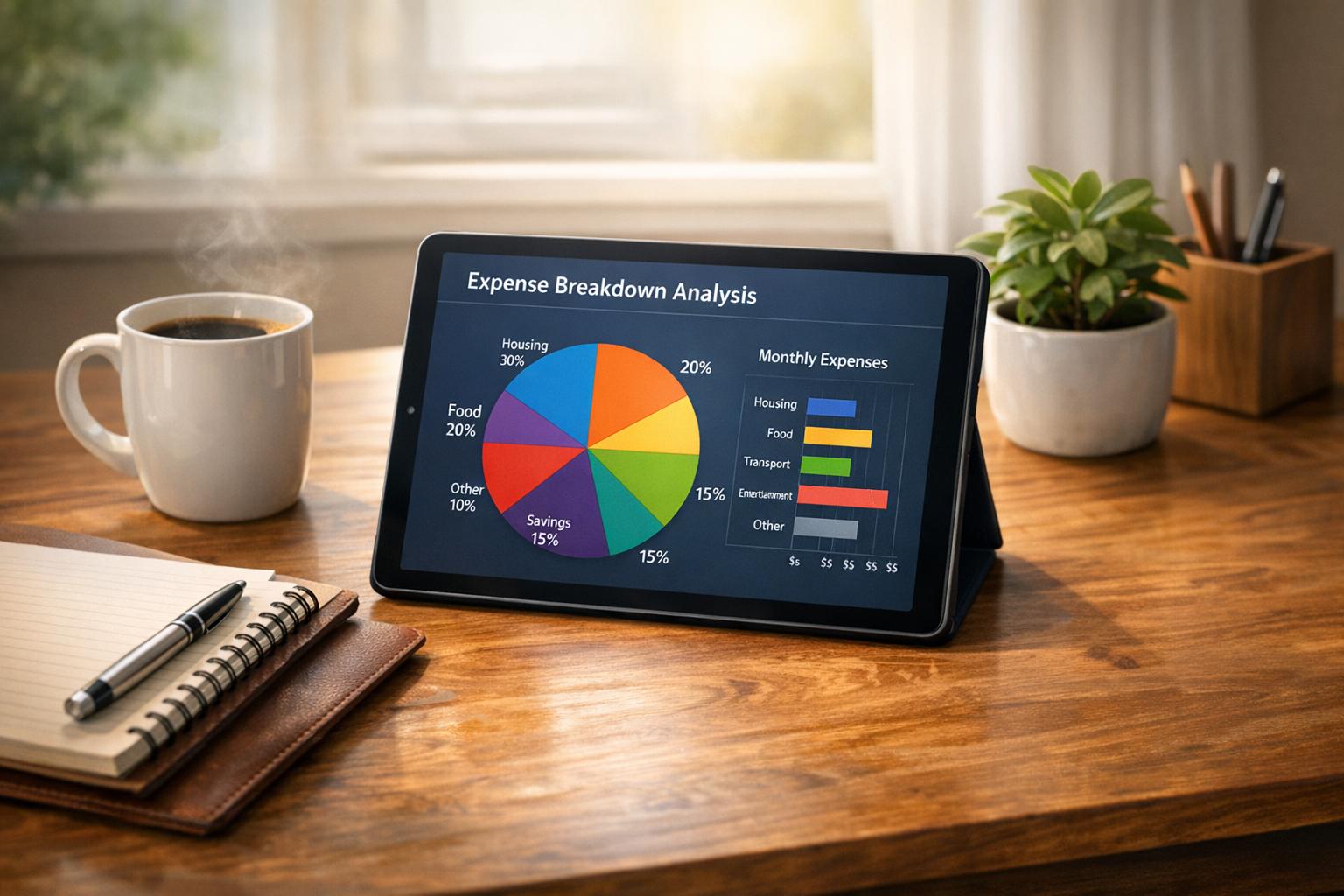Variance Analysis in FP&A: Key Metrics to Track

Variance analysis helps businesses compare actual financial results against their plans, revealing gaps and trends. It’s a critical tool for understanding performance, identifying issues, and making informed decisions. By analyzing deviations in revenue, expenses, gross profit, EBITDA, cash flow, and COGS, companies can pinpoint areas to improve efficiency or adjust strategies.
Key takeaways include:
- Favorable vs. Unfavorable Variances: Favorable variances exceed expectations (e.g., higher revenue, lower costs), while unfavorable ones indicate shortfalls.
- Steps to Conduct Analysis: Gather accurate budgeted and actual data, calculate variances (both dollar and percentage), and perform root cause analysis using methods like the "5 Whys."
- Metrics to Monitor: Revenue by product, operating expenses by department, gross profit, EBITDA, cash flow, and COGS.
- Actionable Responses: Address unfavorable variances through budget adjustments, cost controls, or reallocating resources. For favorable variances, assess sustainability.
Consistency in reporting, regular reviews, and leveraging FP&A tools or expert support can enhance the process. Variance analysis isn’t just about numbers - it’s about using insights to guide better decisions.
Steps for Conducting Variance Analysis
Turning raw financial data into meaningful insights requires a structured approach. Variance analysis, when done systematically, can reveal valuable details about your company's financial performance. Here’s how to tackle it step by step.
Identifying Budgeted and Actual Amounts
The first step is to gather accurate data for both your budgeted projections and actual results. This means consistently collecting and categorizing information to ensure a reliable comparison.
Start by pulling budgeted figures for revenue, expenses, and profit targets from your original financial plans. Then, gather actual results from your accounting systems, making sure they match the same time periods and categories. Accuracy is critical here - double-check that your actual data includes all relevant transactions and adjustments, and confirm that your budget numbers haven’t been revised without proper documentation.
Key metrics to focus on include:
- Revenue by product line or service category
- Operating expenses broken down by department
- Cost of goods sold (COGS)
- Net income
For growing companies, it’s crucial to monitor metrics like customer acquisition costs, monthly recurring revenue, and cash burn rates. Partnering with financial advisory services, such as Phoenix Strategy Group (https://phoenixstrategy.group), can help ensure the data you’re working with is both accurate and actionable.
Once your data is in place, you’re ready to measure the differences.
Calculating Variances
With reliable budgeted and actual figures, the next step is to calculate both dollar and percentage variances. These calculations will show how actual performance stacks up against your plans.
- Dollar variance: Subtract the budgeted amount from the actual amount. For example, if your actual revenue is $150,000 and your budgeted revenue was $125,000, the variance is $25,000.
- Percentage variance: Use the formula: (Actual ÷ Budgeted – 1) × 100. Using the same example, the percentage variance would be: ($150,000 ÷ $125,000 – 1) × 100 = 20%.
Both calculations provide unique insights. A $5,000 variance might seem large, but if it’s only a 2% deviation on a $250,000 budget, it may not be a major concern. On the other hand, a $1,000 variance on a $5,000 budget represents a 20% deviation, which likely requires more attention.
To ensure meaningful comparisons over time, stick to consistent calculation methods. Establish clear processes for handling timing differences, one-time items, and reclassifications to maintain consistency in your analysis.
These calculations lay the groundwork for understanding why variances occurred.
Performing Root Cause Analysis
The final step is digging into the reasons behind the variances. Root cause analysis helps turn numbers into actionable insights that can guide better decision-making.
One effective method is the 5 Whys technique, which involves asking "why" multiple times to get to the root of the issue. For example, if your sales are $30,000 below budget, you might discover that fewer leads converted to sales. Digging deeper, you could find that your sales team was understaffed due to delays in hiring caused by unclear job descriptions.
Another approach is change analysis, which examines what shifted between the budget period and the actual results. Look at internal factors like staffing changes, process adjustments, or pricing updates, as well as external factors such as market trends, competition, or broader economic conditions.
For more complex variances, consider using process mapping to visualize how different activities connect and identify where breakdowns might be happening. This is especially helpful for expense variances that involve multiple departments or processes.
The goal here isn’t to assign blame but to understand the dynamics behind the variance. Focus on uncovering systemic issues, identifying areas for process improvement, or spotting opportunities to capitalize on positive trends.
Finally, document your findings. This builds a knowledge base that can help you better understand your financial patterns and make informed adjustments moving forward.
Key Metrics to Monitor in Variance Analysis
After setting up your variance analysis process, keeping an eye on specific metrics helps highlight both areas of strong performance and those needing adjustment.
Revenue and Expense Variance
Revenue variance analysis isn’t just about comparing total sales numbers. Breaking revenue down by product, customer segment, and sales channel can uncover the real drivers behind trends. Dive deeper into metrics like Monthly Recurring Revenue (MRR), unit sales, pricing changes, and geographic patterns to understand what’s fueling growth - or causing declines.
On the expense side, a detailed review is essential. Monitor departmental costs, such as personnel, marketing, and technology expenses, to identify patterns and ensure spending aligns with your growth goals. Additionally, analyze how gross profit and EBITDA variances reflect your overall operational efficiency.
Gross Profit and EBITDA Variance
Gross profit and EBITDA variances build on revenue and expense insights, offering a closer look at operational performance. Gross profit variance shows how well you’re managing direct costs tied to delivering your product or service. Breaking this down into volume and margin components can help you see whether changes are due to sales quantities or shifts in pricing and cost structures. For example, analyzing product mix can reveal how customer preferences are impacting profitability.
EBITDA variance, on the other hand, strips out the effects of financing, taxes, and accounting to focus solely on operational efficiency. This metric helps businesses evaluate their core performance. By balancing fixed costs with revenue growth, you can spot scaling challenges and address them early.
Cash Flow and COGS Variance
Cash flow and COGS (Cost of Goods Sold) variances complement margin analyses by focusing on liquidity and cost management. Cash flow variance is particularly important because it shows how money is moving through your business. It highlights timing differences and shifts in working capital that can affect daily operations. Analyzing cash flow across operating, investing, and financing activities can reveal where adjustments are needed. For instance, changes in accounts receivable, inventory, or accounts payable can significantly impact cash availability, even if profits remain steady.
A weekly cash flow review can bring timing issues to light, helping you maintain financial stability.
COGS variance directly influences both profitability and cash flow. Variances in material and labor costs - whether due to supplier pricing, volume discounts, productivity, or wage changes - offer insights into procurement and operational efficiency. Service businesses may focus on direct labor and subcontractor costs, optimizing resources and pricing strategies. For product-based businesses, inventory-related COGS variances can signal supply chain issues, inaccurate demand forecasting, or inventory management challenges. Seasonal businesses, in particular, need to understand how inventory timing affects both COGS and cash flow.
Manufacturing companies can take this a step further by analyzing production efficiency, material usage, and overhead absorption to identify opportunities for cost control and process improvements.
The interplay between these metrics is crucial. For example, aggressive pricing strategies aimed at boosting revenue might increase sales volume but also create gross profit variances. Understanding these relationships allows growth-stage companies to strike a balance between scaling up and maintaining profitability.
Interpreting and Responding to Variances
Turning numbers into meaningful actions is what separates effective financial management from mere number-crunching. It’s not just about knowing the figures - it’s about understanding them and making decisions that drive real change.
Evaluating Favorable vs. Unfavorable Variances
Favorable variances happen when actual results exceed expectations - like earning more revenue than planned or spending less than budgeted. On the flip side, unfavorable variances occur when revenue falls short or costs exceed projections, which can strain your bottom line.
But numbers alone don’t tell the full story. It’s important to focus on variances that have a significant impact. For example, a $500 overspend on office supplies doesn’t carry the same weight as a $50,000 drop in monthly recurring revenue. Prioritize variances that involve large sums or affect key business objectives.
Recurring unfavorable variances can point to deeper, systemic issues that need long-term solutions, while consistent favorable variances can signal opportunities to strengthen financial stability. Paying attention to these patterns helps you identify where to focus your efforts and how to respond effectively.
Developing a Response Plan
Once you’ve identified key variances, the next step is to figure out why they happened and what to do about them. For unfavorable variances, dig into the root causes. For example:
- Was a revenue shortfall caused by market conditions, increased competition, or internal problems like poor execution?
- Did an expense overrun stem from unexpected vendor price hikes, poor planning, or changes in project scope?
If variances reflect ongoing challenges rather than one-off issues, revising your budget may be necessary. For instance, if customer acquisition costs have permanently risen due to market saturation, adjusting your budget ensures expectations align with reality.
Another option is reallocating resources to improve overall performance. If one department consistently beats its budget while another struggles, shifting funds or personnel can help rebalance efforts. For example, you might redirect marketing dollars from underperforming campaigns to those driving better results.
Cost controls and efficiency measures can also reduce unfavorable variances. This might involve renegotiating supplier contracts, cutting non-essential spending, or streamlining workflows. Sometimes, the best approach isn’t cutting costs but spending smarter - investing in areas that deliver better returns.
For revenue shortfalls, actions might include launching targeted marketing campaigns, tweaking pricing strategies, or exploring new sales channels. The right response depends on what your analysis reveals about the underlying issues.
Using Technology and Expert Support
Modern financial tools simplify variance management by automating data collection and analysis. FP&A software can pull data from multiple sources, calculate variances in real time, and flag significant deviations through dashboards and alerts. These tools enable you to spot trends and make adjustments before small problems snowball into bigger ones.
For businesses in growth stages, fractional CFO services - like those offered by Phoenix Strategy Group - provide specialized expertise in interpreting variances and crafting response plans. These services combine advanced technology with strategic advice, helping companies align their variance management with broader goals like scaling operations or securing funding.
Phoenix Strategy Group, for example, uses proprietary data and advanced tools to go beyond basic variance reporting. They offer actionable insights and strategic recommendations, making their expertise especially valuable when dealing with complex financial challenges.
sbb-itb-e766981
Best Practices for Variance Analysis
To make variance analysis effective and scalable, you need structure, consistency, and the right tools. These elements work together to turn raw data into actionable insights.
Establishing Standardized Reporting
Consistency is the foundation of any successful variance analysis process. Using standardized templates and sticking to uniform procedures reduces confusion and ensures reports are easily comparable across time periods and departments.
Sabrinthia Donnelly, Senior Copywriter at Finance Alliance, emphasizes that a clear performance report should include identified variances, their causes, corrective actions, and outcomes. Keep the language simple, avoid jargon, and use visual aids like charts, graphs, or tables to make the data easier to digest.
Creating clear workflows for preparing reports, setting deadlines, and distributing them helps avoid delays and ensures everyone knows their responsibilities. Once standardized reporting is in place, the next step is determining how often variance analysis should be conducted.
How Often to Conduct Variance Analysis
Regular monitoring is key to keeping your finances on track. The ideal frequency for variance analysis depends on the nature of your business, but monthly or quarterly reviews are common.
- Monthly reviews work well for businesses with volatile revenue streams or tight cash flow, as they allow for quick identification and resolution of issues.
- Quarterly reviews provide a broader perspective and are better suited for businesses with more stable operations.
For example, a seasonal retail business might benefit from monthly reviews during busy periods and quarterly reviews during slower times. Even if you're a smaller organization with limited resources, a simplified monthly review of key variances is often better than waiting too long and missing critical issues.
Improving Accuracy with Real-Time Data
Real-time data can take variance analysis to the next level, turning it from a purely retrospective process into a proactive management tool. With real-time insights, you can spot and address problems as they arise.
Automated dashboards that integrate data from accounting systems, CRM, and payroll help streamline the process. Built-in validation checks and alerts further enhance accuracy, flagging outliers or unusual entries. For instance, setting alerts for expenses that exceed a certain threshold allows you to catch potential issues early.
Integration across systems adds even more value. When variance analysis tools pull data from multiple platforms simultaneously, you get a complete view without the headache of manual consolidation. This approach is particularly useful for companies using Phoenix Strategy Group's services, which combine cutting-edge technology with financial expertise to deliver comprehensive insights.
For example, if your analysis reveals a 20% spike in marketing expenses, you can immediately implement cost-control measures. By leveraging automated tools, conducting regular reviews, and presenting clear visual reports, businesses can better manage their finances and improve overall performance.
Start by focusing on the metrics that matter most to your business, and as your systems evolve, expand your real-time capabilities to cover additional variances that impact your bottom line.
Key Takeaways from Variance Analysis in FP&A
Variance analysis plays a crucial role in turning raw financial data into actionable insights. By focusing on six key metrics - revenue, expenses, gross profit, EBITDA, cash flow, and COGS variances - you can get a clear picture of how actual performance stacks up against budgeted expectations.
What sets effective variance analysis apart is root cause analysis. Instead of just identifying variances, dig deeper to uncover their origins. Are they the result of operational inefficiencies, shifts in the market, or forecasting errors? This deeper understanding helps you implement precise solutions. Keep in mind that favorable variances exceed expectations, while unfavorable ones signal shortfalls. However, context is critical - a variance that looks favorable on the surface may conceal underlying problems.
Regular and consistent reviews are non-negotiable. These reviews ensure that financial insights are timely and relevant, keeping you ahead of potential problems.
Modern FP&A tools and expert advisory services, like those offered by Phoenix Strategy Group, can elevate your variance analysis. These resources provide the real-time accuracy and strategic guidance needed to make your analysis more impactful.
When you combine consistent monitoring, detailed root cause analysis, and advanced technology, variance analysis becomes a powerful, proactive tool. It allows you to identify issues early, replicate successful strategies, and make informed decisions that enhance financial performance and align with your strategic goals.
FAQs
What steps can businesses take to ensure accurate data for variance analysis?
To get reliable results from variance analysis, businesses need to focus on data validation and reconciliation. This means double-checking information across different sources and using automated tools to catch any errors. Regular audits and updates to data sources are also crucial to keep everything accurate.
Creating a single source of truth and setting up clear data governance policies can make data even more dependable. These steps ensure that variance analysis delivers meaningful insights, helping businesses make smarter financial decisions and plan effectively.
What challenges do companies face when analyzing favorable and unfavorable variances?
Interpreting variances can be a tricky task for companies, and a few key factors often make it even harder. For starters, data accuracy problems - like incomplete or outdated records - can throw off insights, leading to unreliable conclusions. On top of that, teams often face the challenge of limited time and resources, which means they might not have the capacity to dig deep enough to uncover the real reasons behind the variances.
Determining whether a variance is genuinely positive or negative isn’t always straightforward. It requires proper context and careful interpretation. Without a clear framework in place, businesses can find it difficult to tie these variances to actionable steps, ultimately complicating their financial planning and decision-making processes.
How do technology and expert advisory services improve variance analysis in FP&A?
How Technology and Expertise Transform Variance Analysis in FP&A
Technology is changing the game for variance analysis in FP&A. By automating data collection, providing real-time updates, and using predictive analytics, it’s now easier to spot discrepancies faster than ever. These tools not only improve accuracy but also free up valuable time, letting teams focus on bigger-picture strategies instead of tedious manual tasks.
But technology alone isn’t enough. Expert advisory services add an extra layer of value by offering deep financial insights, helping teams understand variances clearly, and promoting accountability across departments. Together, this blend of advanced tools and expert guidance helps businesses make smarter decisions, boost financial performance, and adapt swiftly to shifting market demands.




